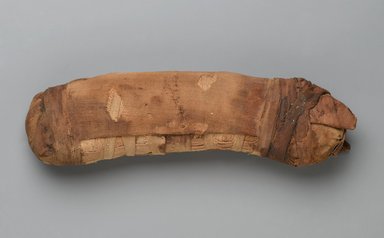
Artist:Egyptian
Medium: Linen, stones, soil, plant matter
Geograhical Locations:
Dates:664–30 B.C.E.
Dimensions: 2 1/8 x 3 x 10 3/8 in. (5.4 x 7.6 x 26.4 cm)
Collections:
Exhibitions:
Accession Number: X1179.3
Image: X1179.3_PS2.jpg,
Catalogue Description: The object is a mummified form in the shape of a small cat. Radiographs indicate the absence of skeletal material. Slightly more radio-opaque areas in the head and torso are likely not animal remains at all, but rather compacted soil and plant material, added to give weight to the mummified form. This interior material is wrapped in strips of linen; this textile is plain woven with Z-spun flax threads. The inner wrappings, visible through a large rectangular loss in the outer wrappings along the torso, consist of thin strips of medium textured linen in alternating vertical and horizontal layers. The outer wrapping consists of a single sheet of medium textured linen bound at the neck and caudal end with thin, horizontally wrapped, thin linen strips. One narrow, folded strip of linen, attached underneath the binding around the neck, runs from the back of the neck over the top of the head. There are two ear-shaped appendages on either side of the head attached underneath binding strips around the neck; these forms are fashioned from folded strips of linen, possibly wrapped around a rigid core. The latter observation is based the relative opacity of these appendages in the radiographs and their stiffness. The outer wrappings, particularly those around the neck, are generally darker than the exposed inner wrappings. It should be noted that the bindings around the neck and caudal end are slightly waxy in appearance. Condition: Overall the object is in fair and stable condition. There is a large, rectangular loss in the outer wrapping along the torso; the size, shape and straight edges of this loss likely indicate that it was cut. The vertical edges of this loss are not attached to the inner wrappings and are lifting significantly. There are several additional losses in the outer wrapping; these appear to be torn rather than cut. The edges of the losses and of most of the linen strips are frayed and many are lifting slightly. There are several partially detached pieces of linen on the top of the head and on the tip of the proper right ear. The proper left ear is loosely attached. The wrappings are generally stained, soiled and dusty.